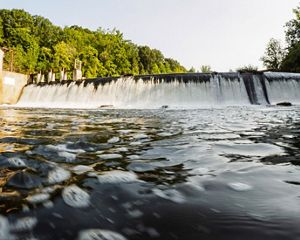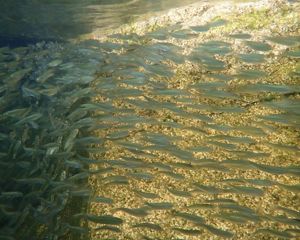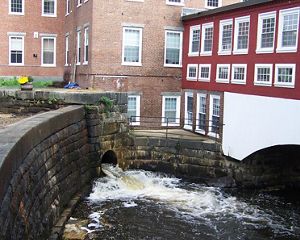Dam Removal on Big Indian Creek
Removing low-head dams promotes habitat and recreation safety.
Conservation and public safety don't often coincide. But in Indiana the growing movement to remove low-head dams from our rivers and streams has benefits for both nature and people.
Nearly five years ago, Indiana residents lost a kind, joyful 24-year-old to the Maumee River. Sean Hiebel died in a kayaking accident after paddling over a low-head dam and getting caught in the circular current that was hidden on the other side. Low-head dams don’t look dangerous. They appear small and navigable, but they’re notoriously called “drowning machines.”
Low-head dams are also a threat to fresh water and healthy habitats. Low-head dams block the upstream movement of fish and other species, impacting their reproductive cycle.

Eastern Hellbender Salamander
Big Indian Creek was identified as a viable potential site for reintroducing hellbender salamanders, but only if the two large low-head dams were removed.
Dozens of people are injured or killed each year from drowning at low-head dams. Dams block safe navigation on rivers for boaters and degrade the quality of fish for anglers. Dam failure becomes a possibility as structures age. This can result in flooding, property damage and even loss of life downstream. Maintenance and repairs for low-head dams can be costly.
The Nature Conservancy is pursuing removal of low-head dams because it is a win-win for conservation AND human safety.
The Nature Conservancy led a team to assess the potential for removing two low-head dams from Big Indian Creek in southcentral Indiana, which is part of the much larger Mississippi River basin. Removal of the dams reconnects stream habitat for fish, freshwater mussels and hellbender salamanders while also eliminating safety concerns.
What Is a Low-Head Dam?
Low-head dams are man-made structures in rivers that pool upstream water for various reasons. The Big Indian Creek dams created pools that were a former water supply for the Town of Corydon. Low-head dams normally produce vertical water surface drops of one to 15 feet. The Big Indian Creek dams were 10 and 13 feet tall, respectively. Indiana has nearly 150 documented low-head dams.
Low-head dams alter natural habitat and impair how a stream behaves. Adverse effects of low-head dams include the following:
- Low-head dams block the upstream movement of fish and other species, impacting their reproductive cycle.
- They change free-flowing river habitat and turn it into pond-like habitat, an environment where fish adapted to free-flowing conditions do not fare well. This leads to substantial decreases in the types of fish in a dammed river.
- Water quality is impaired by low-head dams. Dams create conditions favorable to algal growth by slowing water and trapping sediment and nutrients. This can significantly deplete the oxygen in the water behind a dam, leading to fish kills.
What Are the Ecological Benefits of Removing a Low-Head Dam?
Dam removal improves water quality by allowing water to flow naturally. Natural flows allow for normal sediment load distribution and high dissolved oxygen.
Fish and invertebrate species greatly benefit from dam removal. Many dams act as barriers, because they were designed and constructed without passage for fish and invertebrates. Dam removal restores free passage upstream and downstream, which is crucial to migration patterns. A greater diversity of fish and invertebrate species is often documented both up and downstream following dam removal.
Bring Back the Hellbender!
Indian Creek is a scenic karst stream that connects by surface drainage to the Ohio River, and via underground channels to the Blue River.
The Blue is also a high-quality karst stream, and the only river in Indiana that still supports Eastern hellbender salamanders. Eastern hellbenders are declining throughout their range, and Purdue University and the Indiana Department of Natural Resources are currently augmenting juvenile hellbenders in the river.
Help Us Help the Hellbender
Your support will help us improve fresh water across Indiana.



